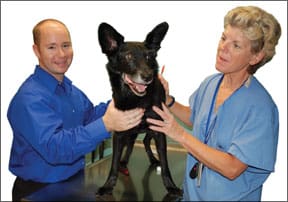New Therapy for Canine Brain Cancer
Breakthrough experimental treatment includes surgery, gene therapy, and a vaccine
The University of Minnesota College of Veterinary Medicine opened clinical trials in June 2009 for dogs with brain cancer. Any dog with a primary brain tumor (one that originates inside the brain) may be eligible. The program will cover almost all costs for dogs enrolled in the trial.
Batman is a 10-year-old German Shepherd-mix with an aggressive type of brain tumor one that usually causes death within a month of diagnosis. In August 2008, Batman was the subject of what has developed as a breakthrough experimental treatment. One year later, Batman has no evidence of the disease a response so impressive that the National Cancer Institute is funding further research for 50 dogs. If additional grants and donations come through, the number will be increased to 100 dogs. Without funding, treatment would cost between $10,000 and $20,000 per dog.
Photo by Sue Kirchoff 288
The new treatment consists of three phases. Surgery is done to remove as much of the tumor as possible. The site is then treated with a form of gene therapy designed to attract the dogs immune system to destroy any remaining tumor cells. Finally, a vaccine is made from the dogs own cancer cells and administered to prevent tumor recurrence.
Since Batmans success, eight more dogs have been treated. In each case, their tumors shrank or disappeared.
This new type of treatment has the potential to be used for many other forms of cancer in both dogs and humans. Two comparative oncology specialists are working together: one is a veterinary surgeon, and the other heads the universitys neurosurgery gene therapy program. Their hope is that the lessons learned from treating dogs will lead to better treatment options for humans with brain tumors as well.
Mary Straus
For more information:
University of Minnesota College of Veterinary Medicine, (612) 624-7441; www.cvm.umn.edu
Veterinary Chain Stops Providing Cosmetic Surgery
Banfield, The Pet Hospital, will no longer crop ears, dock tails, or devocalize dogs
In July, the nations largest chain of animal hospitals, with more than 730 locations and 2,000 veterinarians, announced that it will no longer perform ear cropping, tail docking, or devocalization on dogs.
Banfield, The Pet Hospital, based in Portland, Oregon, has determined that its in the best interests of its clients animal companions to stop offering these cosmetic surgeries. In doing so, Banfield is conforming with this position statement passed by the American Veterinary Medical Association (AVMA) in November 2008:
The AVMA opposes ear cropping and tail docking of dogs when done solely for cosmetic purposes. The AVMA encourages the elimination of ear cropping and tail docking from breed standards.
The Canadian Veterinary Medical Association also opposes cosmetic surgeries. Ear cropping and tail docking are banned in Australia, Finland, Germany, Iceland, the Netherlands, Norway, Switzerland, Sweden, Scotland, and parts of Austria.
The American Kennel Club, on the other hand, remains a loud voice of opposition to anti-cropping and anti-docking policies and legislation. The AKC position statement says, The American Kennel Club recognizes that ear cropping, tail docking, and dewclaw removal, as described in certain breed standards, are acceptable practices integral to defining and preserving breed character and/or enhancing good health.
The AKC further states, Any inference that these procedures are cosmetic and unnecessary is a severe mischaracterization that connotes a lack of respect and knowledge of history and the function of purebred dogs.
The Banfield announcement was released just in time to support the efforts of animal advocates working to ban devocalization of dogs in the state of Massachusetts, House Bill 344. That bill was scheduled to be heard in the state legislature in early August.
Pat Miller
Missing the Point
Removing or reducing a dogs teeth fails to address the cause of his aggression
In July, the LA Times reported on the story of Cotton, an American Eskimo Dog with aggressive behaviors, whose owners had opted for a procedure known as disarming the removal or reduction of healthy teeth as a treatment for canine aggression. The owner had reportedly tried everything to eliminate the dogs aggression, including clicker training, high-pitched electronic tones, pepper spray, throwing soda cans filled with rocks, and two visits from Cesar Millan.
While watching an Animal Planet program on extreme biters, the owner found Dr. David Nielsen, a veterinary dentist based in Manhattan Beach, who talked about a miracle fix: the disarming procedure.
Instead of extracting canine teeth, Dr. Nielsen cuts away 4 millimeters of tooth using a CO2 laser. He acid-etches the live pulp within, fashions a bell-shaped cavity that he packs with composite, and light-cures the top for a smooth, flat finish. He also blunts the sharp incisors.
The owners had the procedure performed on their dog at a cost of $1,600. They report that their dog still attempts to bite, but the worst damage hes done has been light scoring to the leather boot of their gardener, after 30 seconds of ferocious gnawing. A month after Cottons disarming, he still goes after strangers, but the severity of his bites have been reduced.
This approach has not been embraced by qualified, knowledgeable behavior professionals, nor do the results strike most positive trainers as a success.
Behavior studies confirm that canine aggression is best addressed through behavior modification programs that utilize classical counter-conditioning and desensitization; training that utilizes operant conditioning, such as the Constructional Aggression Treatment (CAT) protocol developed by behavior analysts Kellie Snyder and Dr. Jesus Rosales Ruiz, is also very useful for treating aggression. A combination of operant and classical conditioning, as described in Leslie McDevitts book Control Unleashed or Emma Parsons Click to Calm, can also produce a positive change in a dogs behavior.
Behaviorists are not alone in their criticism of disarming procedure; the American Veterinary Medical Association (AVMA) also recommends the use of appropriate behavior modification programs. The AVMA issued a policy statement on the removal or reduction teeth in June 2005:
The AVMA is opposed to removal or reduction of healthy teeth of dogs as a treatment for canine aggression. This approach to managing aggression does not address the cause of the behavior. The welfare of the patient may be adversely affected because the animal is subjected to dental procedures that are painful, invasive, and do not address the problem. Removal or reduction of teeth for nonmedical reasons may also create oral pathologic conditions.
Dogs may still cause severe injury with any remaining teeth, and removal or reduction of teeth may provide owners with a false sense of security. Injury prevention and the welfare of dogs are best addressed through behavioral assessment and modification by a qualified behaviorist.
Pat Miller
New DNA Test for Boxer Cardiomyopathy
Both carriers and affected dogs can now be identified with certainty
Cardiomyopathy is a form of heart disease that affects a number of different breeds, including Boxers, Doberman Pinschers, and Cocker Spaniels. Boxer Cardiomyopathy, or more specifically arrhythmogenic right ventricular cardiomyopathy (ARVC), is an inherited electrical conduction defect that causes an arrhythmia, or irregular heart beat. The affected heart does not pump blood efficiently, leading to changes in the heart muscle that can cause fainting and sudden death. Because the arrhythmia may occur infrequently, it can be difficult to detect on examination, even by a specialist.
courtesy UMN 288
In April, Kathryn Meurs, a veterinarian at Washington State Universitys College of Veterinary Medicine, announced that she had identified the mutant gene responsible for Boxer Cardiomyopathy. The gene is autosomal dominant; if a puppy receives it from just one parent, he can be affected. Even a Boxer-mix with the mutant gene could be affected. (Affected parents can produce normal offspring; pups who do not receive the gene will not be affected.)
A DNA test to screen for this mutation is now available from WSU. The test can be completed with an in-home cheek-swab kit or a blood sample taken by your veterinarian, and costs just $60.
The DNA test will be useful to breeders who can now hope to eliminate carriers from the breeding pool. It will also be helpful to pet owners, who can manage the disease even before any symptoms are seen, with inexpensive medications that can extend the dogs life. The average monthly costs for treatment are estimated to be less than $100, according to Dr. Meurs. It could also be used to screen puppies before they are brought home.
Mary Straus
For more information:
WSU College of Veterinary Medicine Veterinary Cardiac Genetics Lab
See vetmed.wsu.edu/deptsVCGL/
Boxer/test.aspx or call
(509) 335-6038






